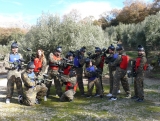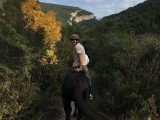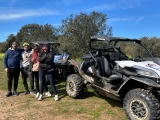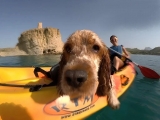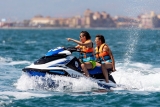First and foremost, it’s essential to consider these recommendations for undertaking the Camino—you can’t be too careful.

It all began with the discovery of the saint’s remains by the Bishop of Iria Flavia. This event turned Santiago de Compostela into a pilgrimage hub. The Church and the protection of the Knights Templar encouraged devotees from across Europe to follow the Camino—also called the Milky Way—converging after crossing the Pyrenees via Somport and Roncesvalles at Puente la Reina. The route linking these two towns to Santiago de Compostela is known as the French Way.
CAMINO DE SANTIAGO FROM MADRID
The route we present here begins in Madrid and joins the main path at Sahagún. The section we’ll describe starts at Paseo de las Alamedillas, in the Fuencarral district. From there, following a path towards the Colmenar road, we’ll reach the overpass crossing it. Here, we’ll spot the first yellow arrow of the Camino. Further on, we’ll cross the M40 and the railway to reach Tres Cantos after passing the Goloso halt.

In this town, we’ll look for La Chopera del Arroyo de la Tejada, then follow the droveway that crosses it, which after 8 km leads to Colmenar. Once there, we’ll head to Calle Pilar de Zaragoza. Nearby, we’ll find the drove road that takes us to Manzanares el Real. Along the way, we’ll cross the Manzanares River and continue on a droveway to the Valderrevenga estate. Two km later, we’ll take a right fork uphill, then descend to the village.
Just before the entrance—before crossing the river—we’ll turn left onto the path marked by the red-and-white GR-10 signs, passing first through the Parque Natural de la Pedriza and the village of Navacerrada, until Cercedilla, our next destination.

Leaving Manzanares, we’ll pass the entrance to the Parque Natural de la Pedriza, which we’ll skirt for several kilometres. Then we’ll reach Matalpino. From here, we’ll exit via the Vista Real urbanisation and continue on the GR (Gran Recorrido) to Navacerrada, where we’ll head to the town hall in the square. A street on the right resumes the GR, and via Calle Abel, we’ll set our course for Cercedilla. There, we’ll find the Plaza Mayor to continue along Avenida del Generalísimo and then Calle Capón. We’ll follow this street out of town to the Roman Road, which in just over an hour and a half leads to the Puerto de la Fuenfría.
From there, following the wide forest track—sometimes spotting remnants of the Roman road, other times walking on tarmac—we’ll descend gently to Segovia. We’ll leave this magnificent city via Paseo de San Juan de la Cruz, pass the Puerta de Santiago, and head towards the floodplain of the Eresma River.
By this stage, we’ll have realised the importance of not packing unnecessary items (the backpack shouldn’t exceed 7–8 kg per person). Until Sahagún—ten days from Madrid—there are no hostels, but we won’t have issues if we request lodging at churches or town halls. Another option is carrying a lightweight tent or bivvy bag to sleep outdoors. Meals can be sorted at bars, restaurants, or supermarkets.

In short: avoid overloading yourself. Spare clothes and changes will make up most of your luggage. Don’t forget a hat, sunglasses, and sunscreen. Toiletries and a towel are also essential, as is a map of the area we’ll cover until Sahagún, where we’ll join the French Way, clearly marked all the way to Santiago de Compostela.
Leaving Segovia with the Alcázar to our left, we’ll head to Zamarramala. Here, we’ll find Calle de la Iglesia, then walk past the cemetery on the right. Later, we’ll pass under the ring road and at the first fork take the right path, then the left at the second, leading to Valseca. Near the main square (with the town hall), we’ll take Calle Los Huertos to exit towards the namesake municipality. About a kilometre ahead, we’ll follow the main path right at a carved stone marker.
We’ll enter Los Huertos via the road from Hontanares del Eresma, which turns left and ends. We’ll continue on the replacement path to the Hermitage of Nuestra Señora, then towards the Segovia-Medina del Campo railway. After crossing the tracks, we’ll follow them to km 19.4, where a bridge lets us cross the Eresma River. 500 m later, we’ll turn right towards a pine forest, traversing it to reach Añe, which we’ll leave via the Armuña road to Pinilla Ambroz. From the village church, a track leads to Santa María la Real de Nieva.

The route’s stages aren’t fixed by distance or towns. Thus, hikers must plan them based on time and energy. Until Sahagún, we can align stage ends with villages for lodging and/or hot meals. However, once on the French Way, such issues vanish, replaced by overcrowding challenges.
Regardless, aim to walk 7–8 hours daily to cover a reasonable distance per stage.
From Santa María to Nieva, we’ll take a left fork 200 m past the junction. In Nieva, we’ll cross the village centre and rejoin the road towards Nava. Soon, we’ll reach a bridge over a stream. Without crossing, we’ll follow the right-hand path through pines, then parallel to the railway to Nava. We’ll exit via the Navas de Oro road, taking a left path that skirts the Eresma River gorge to Coca.
From here, the path continues left of the Eresma, passing the "Ecological Trail of Coca’s Pine Forests" to Villeguillo. We’ll exit via the Olmedo road, then follow the Cañada de los Gallegos, crossing the C-112 to Alcarazén in Valladolid.

Here, we’ll find San Pedro Church, then walk to the N-403 junction, crossing to a three-way fork. We’ll take the left path, parallel to the Eresma, later crossing via a local road. Immediately after, a small drove road leads to Valdestillas and Puente Duero. The medieval bridge namesake will take us across the Duero River to Simancas, its castle visible ahead.
Hostels beyond Sahagún are mostly staffed by volunteers. They’re free, but a modest donation helps maintenance. They offer bunks, toilets, and a kitchen. A small laundry area is also available. In summer, demand often exceeds capacity. Priority goes to walkers over cyclists, and among them, those with a pilgrim’s credential.
We’ll reach Simancas after a pine forest and cross the Pisuerga via the Roman bridge. From there, we’ll pass under the motorway through a subway, heading to Cigüeñuela. Exiting via the high side, we’ll take a left fork at a junction, then right after 1 km to Wamba.
From Wamba’s hermitage, a trail leads to Peñaflor de Hornija, 7 km away. Crossing the Hornija River, we’ll reach Castromonte, then follow the Villabráxima road to Valverde de Campos. Here, we’ll track the disused halt to the dismantled railway, then the N-611 to Medina del Río Seco.

We’ll cross town via the main square and Santiago Church, rejoining the railway near the N-601. After 500 m, we’ll turn right to the N-601 at a junction, spotting GR-26 markers (red-and-white stripes).
Seasoned hikers advise: train for 2 months beforehand (weekend hikes or gym), use lightweight, flexible boots, and start early to secure hostel beds—especially on the French Way. Stick to yellow markers until Sahagún.
From Medina del Río Seco, we’ll follow the GR back to the N-611, cross it, and continue to the N-601. Walking left of it, we’ll reach Berrueces, exiting via the Ermita de Pedrosa.

Past the Virgen Fountain, the trail continues to Moral de la Reina del Camino. We’ll exit west via a clear bridleway to Cuenca de Campos (8 km). From there, the San Bernardino Hermitage leads to the dismantled railway, then a road to Villalón de Campos. Exiting via the Fontihoyuelo road, we’ll follow markers to that village.
From Fontihoyuelo, the Arroyo Hondo path leads to Santervás (via the cemetery road). We’ll follow the river to Arenillas de Valderaduey (León). Crossing a bridge, we’ll walk the right bank to Grajal de Campos, then 5 km along a wide path to Sahagún, joining the traditional route.

Santiago de Compostela boasts a spectacular old town, where the Santiago Cathedral—endpoint of the Way of St. James—takes centre stage. Visiting its museum after passing the Portico of Glory is a pilgrim’s rite of passage and grand finale to a route steeped in centuries of history.
With these guidelines, we hope to aid your decision to walk the Camino, blending the adventure sport of hiking with the culture and history of this legendary journey.





